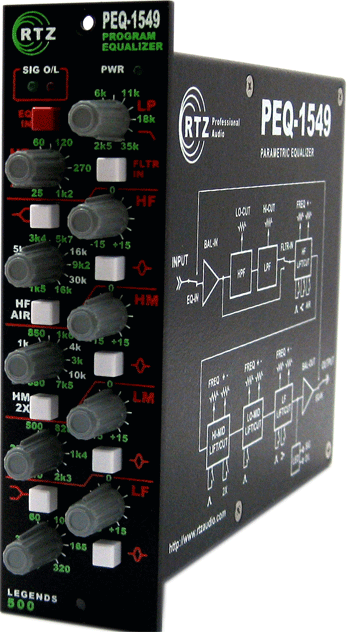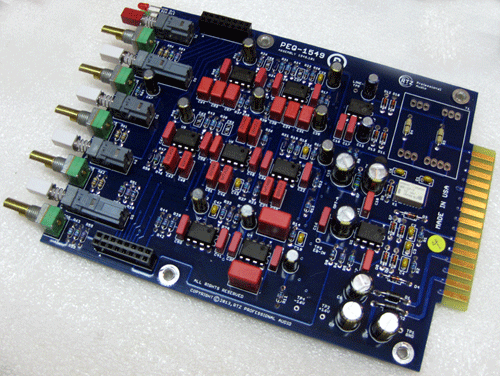 The PEQ-1549 Parametric EQ is RTZ's new entry into their Legends 500 line of single-channel modules for 500 racks. The PEQ-1549 is a four-band parametric equalizer that covers from 25 Hz to 35 kHz with switchable high and low Q modes for all four bands and switchable shelving modes for the high and low frequency bands. In addition, there are continuously variable 2nd order (12dB/octave) high and low pass filters. The HP filter sweeps from 25 Hz to 1.2 kHz while the LP filter varies from 2.5 kHz to 35 kHz.
The PEQ-1549 Parametric EQ is RTZ's new entry into their Legends 500 line of single-channel modules for 500 racks. The PEQ-1549 is a four-band parametric equalizer that covers from 25 Hz to 35 kHz with switchable high and low Q modes for all four bands and switchable shelving modes for the high and low frequency bands. In addition, there are continuously variable 2nd order (12dB/octave) high and low pass filters. The HP filter sweeps from 25 Hz to 1.2 kHz while the LP filter varies from 2.5 kHz to 35 kHz.
Musical Specs
To expand the PEQ's musical usefulness, both the high frequency (HF) and high-mid band (HM) sections are dual-band. In normal mode, the HF band ranges from 1.5 kHz to 16 kHz and, when switched to Air-Band, it spans 3.4 kHz to 35 kHz. The HM band range is 350 Hz to 7.5 kHz but when the 2X switch is engaged, it covers 680 Hz to 16 kHz. The high and low Q values available in the HF section are: 1.1 and 3.4 while the HM section's choices are: 1.5 and 3.8.
The LM or Low-Mid frequency band ranges from 210 Hz to 2.3 kHz with a Q of 1.5 or 3.9. The LF or low frequency band ranges from 30 Hz to 320 Hz with a switchable Q of either 3.4 or a very narrow 12.1.
All Q values are specified at maximum boost/cut and were individually chosen for each section for their musicality--including the higher Q available in the low frequency section making it an exceptional musical tool.
Compact Design
The PEQ's four parametric EQ sections use NE5532 dual op-amps in a state-variable filter topology. The SVF design has the advantage allowing easy and simultaneous adjustment of Q and frequency in each section without interaction. The HP and LP filters use Sallen-Key Butterworth filter circuits. The PEQ uses a THAT Corp. 1206 balanced line receiver for the input and a THAT 1646 balanced output line driver. You can order modules with an optional Lundahl LL2811 output transformer for additional "color" and true galvanic isolation.
Packed Module
Obviously a challenge to build an equalizer with ten knobs and ten push buttons that fit on the front panel of a single slot 500 module, it might be the absolute maximum number of controls readily adjustable by human fingers. To accommodate this, the inside of the PEQ-1549 is a component-packed marvel of multi-layer, electro-mechanical design. It uses a four-layer printed circuit board designed to maximize isolation and minimize the noise floor via a full split ground plane design. The +/- 16-volt power rails are routed on a separate internal power layer.
There are ten conductive plastic pots made by BI Technologies that each have eleven detents with the center position set as unity for boost/cut controls. The six frequency controls (4-bands plus 2 for the HP/LP filters) also have 11 detents and both frequency and gain pots allow fine adjustment in between the detents. Pushbuttons are E-Switch PBH series with silver contacts as are the contacts in the Omcron G6K true bypass relay. One relay is used for the EQ bypass, the other switches the HPF/LPF in/out. Equalizer capacitors are Wima film caps and all electrolytic caps are Panasonic FC series.
In The 500 Rack
 For review I received two PEQ-1549s with the transformer option and I connected them from my API 6B 500 rack to my Pro Tools HD I/O so I could use them as inserts when mixing in the box. At first glance, they appeared daunting with a busy and crowded front panel but the design does allow room to get your fingers in there; plus, the detented rotaries, in 3dB steps, give you a good feel of what you're doing. Once I acclimated and used them for a while, they became super easy to use and get around quickly.
For review I received two PEQ-1549s with the transformer option and I connected them from my API 6B 500 rack to my Pro Tools HD I/O so I could use them as inserts when mixing in the box. At first glance, they appeared daunting with a busy and crowded front panel but the design does allow room to get your fingers in there; plus, the detented rotaries, in 3dB steps, give you a good feel of what you're doing. Once I acclimated and used them for a while, they became super easy to use and get around quickly.
At the top of the module, there is a green power LED, an easy-to-find red, in/out (relay bypass) button and a red O/L LED that lights at +20dB output level. The front panel silkscreened lettering is small and color-coded and, being nearsighted, I liked having the modules close to me for precision tweaking. All four EQ sections of the PEQ have white pushbuttons to toggle between the two Q choices and the two shelving modes. Using shelving mode overrides Q selection.
Five String Bass Guitar
 |
|
One Of Two Internal Circuit Boards In The PEQ-1549 |
The PEQ allowed me to sculpt the tone of a Yamaha five-string electric bass that had onboard active electronics. My goal was to arrive at a big sound that "coupled" to the kick drum and fit into the track well without sounding like a synthesizer.
I began by using the HP filter set to 50 Hz to slim the subsonic--especially important whenever the Yamaha's open B string was played. Using the LF section, I boosted 6 dB at 80 Hz in high Q peaking mode to carve, in a very precise way, the overall size and low-end quality of the bass track.
The bass part was played expertly and smoothly but without a pick. For the mix, the producer required more 'cut' and definition so I used the PEQ's HM section and generously boosted +9dB at 1 kHz in high Q. This extreme EQ did bring up occasional fret/string noises that I either had to edit out or clip gain down later in Pro Tools--but the finished bass sound was all worth it. I got smoothness with more attack and greater clarity using this EQ setting plus it evened out the loud, booming notes without having to resort to heavy-handed compression.
Stereo Electric Rhythm Guitar
The two PEQs fatten up an edgy stereo electric guitar that was recorded with reverb and delay effects. Boosting at 28 kHz shelving using the Air-Band mode in the HF section brighten the sound without getting harsh, strident and fizzy. To that end, I did cut about 1.5 dB (between detents) @ 4 kHz in the HM section with low Q and later added +3dB shelving at 80 Hz using the LF section. This brought the guitar track forward in the mix with a slightly brighter sound but without adding appreciable VU level.
If you slightly overdrive the signal coming from the insert point in Pro Tools into the PEQ and then boost in the LF or LM sections until the O/L LED starts flashing, you'll add the Lundahl transformer's saturation to the guitar's sound that is both subtle and phenomenal. I liked this especially for rhythm parts that were recorded a little too clean--the PEQ got them chunky-thick and unruly sounding.
Drums
While my drummer practiced away, I had enough time to reposition the overhead mics and try different equalization settings on them--I was going for a four or five microphone traditional drum sound in a not so great sounding room. For this kit in this small room, the 2X position on the HM section in low Q sounded great boosting at 10 kHz (bell) and also the LM section in high Q to remove by -3dB. the overall boxy room tone around 800 Hz.
On the same kit's piccolo snare drum I used a Shure SM57 up close and found the high Q position worked well to boost +3 dB at 230 Hz in the PEQs LM section. But I also added a +6 dB shelving boost at 16 kHz with the HF section. This EQ opened up the sound and definitely played down the "coffee can" sound from of the snare drum and room.
I certainly loved the LF section for the kick drum. After locating the frequency center of interest by sweeping frequency using high Q mode , I just switched over to shelf mode, readjusted the boost to taste and I was done. To me, the sound here is like old British EQs such as found in the Trident A Range channel strips.
Task Master
The RTZ Professional Audio PEQ-1549 Parametric EQ is up to any task be it for gentle and smooth mix program touchups, as a tracking utility EQ, or for major emergency surgery for audio on life support. I especially like the HF section's fully adjustable Air-Band mode and the LF section's intense low frequency carving ability for bass guitars and kicks. Wake up your 500 rack with one or two of these little EQ tonmeisters!
Highly Recommended!
